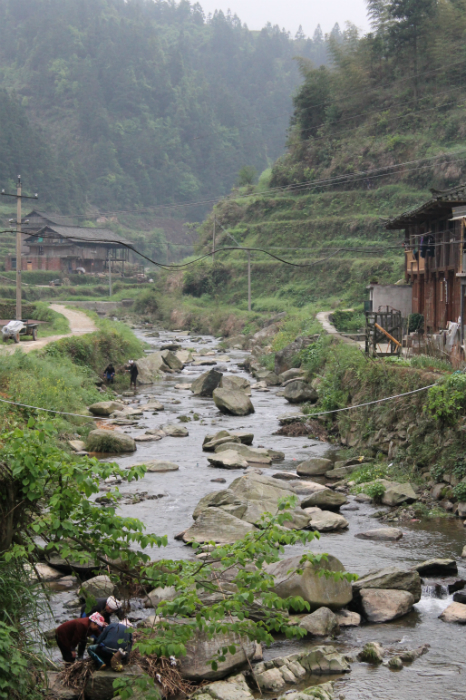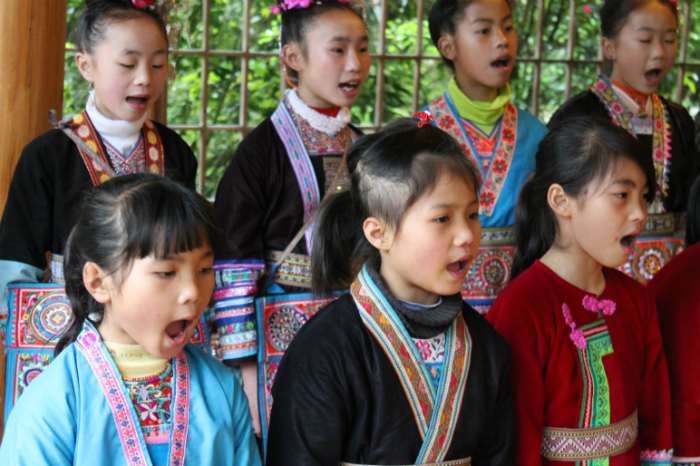Singing and Exploring in Guizhou Province

I recently received an invitation from Dr. Wang Hangguang, director general of Guizhou Province Department of Culture, to join him and his colleagues in Guiyang (the provincial capital of Guizhou, China) to discuss how they could better represent “authentic” traditional music. I wasn’t yet aware that Guiyang is one of the most ethnically diverse and historically one of the least developed provinces.

Eight days later I arrived in Hong Kong, and then boarded a plane to Guiyang along with musicologist Dr. Joanna C. Lee, veteran writer Kenneth Smith (advisors for the China: Tradition and the Art of Living Festival program and co-directors of Museworks Limited, a cultural consultancy) and Rachel Cooper (director for Global Performing Arts and Special Cultural Initiatives of the Asia Society).
In Guiyang we were welcomed at a banquet hosted by Dr. Wang and colleagues from the Department of Culture of Guizhou Province. On reflection, the evening together effectively opened paths of communication, with delicious and plentiful food, and plenty of toasts with the province’s signature liquor called maotai, a fifty-three percent alcohol beverage distilled from sorghum.
Next morning we boarded a van for a half-day journey to rural southeastern Liping County to visit Tang’an, Dimen, and Dengcen, three Dong villages that are among the fifteen comprising the Dimen Dong Eco-Museum. The last couple of hours we drove along narrow, serpentine mountain roads. Most every hill was terraced, filled with two week-old rice seedlings.
In Tang’an, where traditional subsistence agriculture is making way for cultural tourism operations, we had a fine home-cooked meal with the local head of the Communist Party, Mr. Wu, then walked around the village.
On into the mountains and finally up a dirt road to Dimen, where we stayed two nights, and walked down-valley to Dengcen. At the museum’s long table dining hall and in the music room we enjoyed communal meals—all locally raised organic vegetables and bits of meat or fish. Always there was tea, always rice: white rice, black rice, red rice. Who knew?

We heard a Dong girls’ chorus in their polyphonic splendor, accompanied by two male instrumentalists. The next morning we went to a girls’ rehearsal, nearly fifty voices led by a master singer/instrumentalist, and that evening we attended an adult Dong women’s chorus. Members from the adult group will be performing and discussing their lives during the first week of this summer’s Smithsonian Folklife Festival on the National Mall.
These days, most adults leave Dimen to work in the cities of the economically booming nation. Crafts, wine, and teas originating in Dimen and other nearby villages are sold to outside, thus, as I understand it, avoiding tourists and leaving the village relatively whole, culturally speaking.
The Dimen Dong Eco-Museum was started by a Norwegian man who founded it with his own money about 14 years ago, to help protect the area’s cultural traditions. Now it is run by Ren Hexin and his partner, Keisha Du. They are brilliant in what they have accomplished, and I met several young Chinese scholars who have dedicated themselves to the museum’s mission under Ren and Keisha’s mentorship.
Researchers learn traditional medicine, botanical knowledge, crafts, folklore, and music. Much is documented through photos and video. Parents are paid to send their children to the museum, where they learn their traditional music and crafts, as well as emblems of modernity like computer skills. Thereby the museum forges a new generation of tradition bearers.
Nearly a decade after the museum was established, I’m told, the government caught wind of the project and proclaimed it a fine idea. Now the government is among the sponsors, along with member researchers who come from near and far. It all seems to work. It’s brilliant, and it’s inspiring.

D.A. Sonneborn is the associate director for programs and acquisitions at Smithsonian Folkways Recordings. The most satisfying aspects of his career include his encounters with communities quite unlike his Chicago birthplace.

